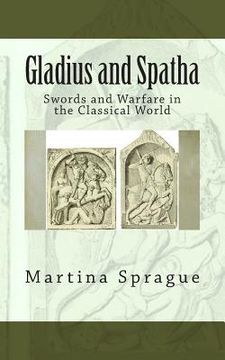Reseña del libro "Gladius and Spatha: Swords and Warfare in the Classical World (en Inglés)"
Ancient Greece and Rome, also referred to as the Classical world, laid the foundation for Western civilization. Because of their geographical proximity to one another and to the Mediterranean Sea, the countries shared many similarities with respect to culture and weapons.The early Greek swords used by infantry had straight two-edged blades, without taper, of equal width from hilt to point. The Spartan sword measured only 14 to 15 inches in length, and was by some considered short and non-frightening. Those who had an intricate understanding of edged weaponry and combat, however, knew that while a long sword carried certain psychological powers, length did not necessarily communicate the deadliness of the weapon.Rome, perhaps the greatest power of the Mediterranean, differed from other civilizations most notably in the notion of citizenship. The Romans were a pragmatic people who did not fail to adopt from other cultures the weapons or technology they found useful. The classic Roman short sword remained in use for centuries; however, while the Romans emulated many of the Greek weapons and armor, they also copied Hispanic daggers as well as straight Hispanic swords during the conquest of Spain in the third century BCE.This book begins with an introduction to bronze, iron, and steel used in weapons and armor in Classical Greece, Britain, Gaul, Rome, and Spain. Next it examines the type of training the soldiers encountered to prepare them for battle. This section focuses mainly on the training of the Roman warriors. The book then analyzes the military organization and battlefield tactics of the Greeks, Romans, and Celts. It ends with a discussion of war wounds and the protection that various types of armor afforded the soldier. The concluding remarks focus on the pragmatic way in which one viewed war in the Classical world.Knives, Swords, and Bayonets: A World History of Edged Weapon Warfare is a book series that examines the history of edged weapons in Europe, Asia, Africa, the Americas, and the Middle East and surrounding areas before gunpowder increased the distance between combatants. The book series takes a critical look at the relationship between the soldier, his weapon, and the social and political mores of the times. Each book examines the historical background and metallurgic science of the knife, sword, or bayonet respectively, and explores the handling characteristics and combat applications of each weapon. The individual books are excerpted from the previously published book, A History of Edged Weapon Warfare, also by Martina Sprague.The full series comprises the following books, which can be read in any order:1. Kukris and Gurkhas: Nepalese Kukri Combat Knives and the Men Who Wield Them2. Machete, Kris, and Throwing Iron: Edged Weapons of Latin America, Indonesia, and Africa3. Cold Steel: The Knife in Army, Navy, and Special Forces Operations4. Japanese Swords: The Katana and Gunto in Medieval and Modern Japanese Warfare5. Chinese Swords: The Evolution and Use of the Jian and Dao6. Yatagan, Khanda, and Jamdhar: Swords and Sabers of Persia and India7. Sickle Sword and Battle Axe: Edged Weapons of Ancient Egypt8. Gladius and Spatha: Swords and Warfare in the Classical World9. Longsword and Saber: Swords and Swordsmen of Medieval and Modern Europe10. Pike, Halberd, and Bayonet: Sharp Weapons in Near Modern and Modern WarfareNote that the books are written for those with an interest in exploring the historical beginnings of edged weaponry, how edged weapons have been used in war in different parts of the world, and the value the soldier attached to his weapon. Military, social, and political history is discussed. Arms collectors or others with detailed interest in the finer points of weaponsmithing may want to look for books that are more heavily illustrated.

